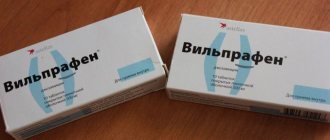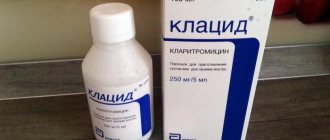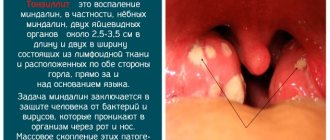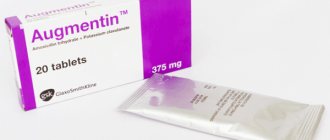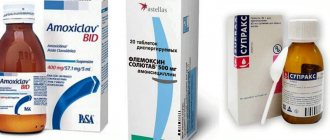Operating principle
Josamycin has a bacteriostatic effect due to the binding of this substance to the ribosomes of microbial cells, as a result of which the synthesis of protein molecules in bacteria is disrupted.
This leads to a slowdown in the reproduction and growth of microorganisms. The medication is active against:
- Streptococci (including pneumococci and pyogenic species).
- Causative agents of diphtheria.
- Meningococcus.
- Peptococci.
- Listeria.
- Staphylococci (including aureus).
- Gonococcus.
- Legionella
- Causative agents of anthrax.
- Bordetell.
- Clostridium.
- Borellium.
- Treponema pallidum.
- Propionibacterium.
- Peptostreptococci.
- Ureaplasma.
- Moraxell.
- Brucella.
- Gonococcus.
- Helicobacter.
- Haemophilus influenzae.
- Chlamydia.
- Bacteroides.
- Campylobacter.
- Mycoplasma.
However, the medicine is often inactive when infected with enterobacteriaceae. It has almost no effect on the normal intestinal microflora. We also note that the medication usually acts on strains of microbes that are resistant to erythromycin and other macrolides.
The tablet is absorbed very quickly in the digestive tract, and food intake does not affect this process in any way. The maximum level of josamycin in plasma is determined approximately one hour after taking the medication. The half-life of the drug is 1-2 hours, with only 10% of the drug excreted by the kidneys, and most of it is excreted in the bile after metabolic changes in the liver.
How does Vilprafen work for ureaplasmosis?
The prescription of this antibacterial drug from the group of macrolides (or its analogues) is relevant in the presence of many infections, but the maximum effect can be observed in the treatment of ureaplasma. The action of Vilprafen is such that its components actively inhibit the growth of bacteria. The concentration of the active substance required to obtain the desired effect is achieved quickly. Already an hour after administration, the substance appears in the blood and begins to act actively.
Active substance
This drug was discovered more than 50 years ago. Thanks to its natural origin, the sale of the medicine is only growing. It is inexpensive, and the main active component of the medicine is the substance josamycin, which has a considerable spectrum of action, including against bacteria that cause infections of the genitourinary system. Josamycin for ureaplasma is considered the most effective component; it remains in the body for a long time and continues to fight harmful bacteria.
Vilprafen treatment regimen
A bacteriostatic medication blocks the production of protein molecules by bacterial cells, which kills harmful organisms. The parasite does not develop resistance to Vilprafen; in addition, the medicine does not affect the microflora of the mucous membrane of the female genital organs and does not provoke the appearance of thrush. The treatment regimen for ureaplasmosis with Vilprafen involves taking 1-2 tablets twice a day after meals. The medicine will be excreted in urine and bile.
Drug interactions
- It is recommended to avoid the simultaneous use of Vilprafen with other antibiotics. This may reduce their effectiveness.
- Inhibits the elimination of xanthines, which can provoke the development of intoxication.
- Combined use with antihistamines, including astemizole and terfenadine, increases the concentration of the latter, which can lead to the development of serious cardiac arrhythmias that are life-threatening.
- Concomitant use of an antibiotic with cyclosporine may lead to an increase in the concentration of the latter, so its level should be monitored throughout treatment.
- It may reduce the effectiveness of hormonal contraceptives, therefore, in order to avoid unwanted pregnancy, it is recommended to additionally use non-hormonal contraceptives.
Interaction
By inhibiting the cytochrome P450 system, it suppresses metabolism and increases the blood concentrations of indirect anticoagulants, theophylline, cyclosporine, carbamazepine, valproic acid, disopyramide, ergot alkaloids (ergotamine, dihydroergotamine) in the plasma. Incompatible with terfenadine, astemizole, cisapride due to the risk of developing severe heart rhythm disturbances caused by prolongation of the QT interval. Simultaneous use with penicillins and cephalosporins reduces the effect of josamycin. Increases the bioavailability of digoxin when taken orally by reducing its inactivation by intestinal flora. Antacids slightly reduce absorption in the gastrointestinal tract.
What does Vilprafen solutab help with?
Microorganisms that are sensitive to the drug include various types of staphylococci (including those producing beta-lactamase), streptococci of various types, anthrax bacilli, diphtheria corynebacteria, gonococci, meningococci, shigella, hemophilus influenzae, pertussis bacillus, legionella, mycoplasma, chlamydia, treponema (pathogens syphilis), rickettsia, some anaerobic bacteria and fungi (Peptococcus spp, Bacteroides spp, Peptostreptococcus spp.).
Based on such great therapeutic activity, we can answer the question of what Vilprafen Solutab helps with:
- Infectious diseases of the respiratory system and ENT organs (gingitis, sinusitis, otitis media, laryngitis, pharyngitis, bronchitis, pneumonia, whooping cough, psittacosis);
- Diseases of the urinary and reproductive organs of infectious origin: prostatitis, gonorrhea, urethritis, chlamydia, syphilis, mycoplasmosis, ureaplasmosis;
- Bacterial skin lesions: pyoderma, acne, furunculosis, lymphadenitis, erysipelas, anthrax;
- Eye diseases (inflammation in the eyelids or nasolacrimal duct of infectious etiology);
- Other specific diseases: diphtheria, dysentery, scarlet fever, etc.
A special advantage of the drug is the possibility of its use in children in the treatment of bacterial respiratory tract infections, due to its pleasant taste and convenient dosage form. Vilprafen Solutab has proven itself well in the treatment of community-acquired pneumonia, especially in people with hypersensitivity to penicillins.
Vilprafen solutab is successfully used for the treatment of bacterial diseases of the reproductive system, which threaten loss of reproductive function, miscarriages and intrauterine infection of the fetus. Josamycin has far fewer side effects than other antibiotics and is less likely to cause the development of resistant strains.
What is ureaplasmosis
In modern specialized literature, the disease is literally called “ureaplasma infection.” It covers the genitourinary system, can occur in both men and women, and is often diagnosed in children. Ureaplasma often lives in the body with other harmful microbes, for example, chlamydia. They are cured with the same drugs. Treatment of ureaplasmosis with antibiotics not related to the tetracycline series is especially effective.
Several internal and external factors can contribute to the development of the disease. These include low immunity in women, the presence of other diseases or infections of the genitourinary system or infections. Women who frequently change sexual partners are especially at risk of infection with microorganisms. Children, as a rule, become infected during childbirth from their mother. Ureaplasma in young girls who are not sexually active is extremely rare.
Instructions for use and dosage
- "Vilprafen Solutab" can be taken in different ways - either swallow the tablet or part of it with water, or dissolve the drug in water, taking a liquid in a volume of 20 ml or more. If the medication dissolves, the suspension should be mixed well before swallowing.
- The daily dose of Vilprafen Solutab for a child is calculated by weight. For 1 kilogram of body weight you need from 40 to 50 mg of the active substance. For example, a 4-year-old child weighing 16 kg will receive 750 mg of josamycin per day, so he is given 1/4 tablet three times a day. If the baby is 6 years old and weighs 20 kg, then the daily dose will be 50x20 = 1000 mg. This amount corresponds to 1 tablet. For such a small patient, the medication is prescribed 1/2 tablet twice a day.
- For people over 14 years of age, 1-2 pieces per day are prescribed, dividing this dosage into 2 or 3 doses. If required, the dose can be increased to 3 tablets per day.
- How long to take the drug is determined by the doctor individually in each case. The duration of taking the antibiotic can be either 5 days or 3 weeks. For example, for streptococcal sore throat, Vilprafen Solutab is prescribed for at least 10 days.
Use of tablets
Vilprafen is prescribed to children whose weight has reached 10 kg or more. Tablets (500 mg) can be given to a child who already knows how to swallow pills. As already mentioned, soluble tablets (1000 mg) are often used to treat bacterial infections in children 1–6 years old. The main thing is to correctly calculate the dose of the drug, since patients under 3 years of age are more likely to experience adverse reactions.
The dosage of Vilprafen depends on the child’s weight:
- less than 10 kg – 40 mg/1 kg of total weight. The daily dose is divided into 2 – 3 equal doses;
- 10 – 20 kg – ½ tablet twice;
- 20 – 40 kg – ½ or 1 pill twice;
- from 40 kg – 1 tablet twice.
Vilprafen Solutab is often given to patients over 3 years of age, and the child can swallow it and wash it down with water or take it in solution form. It is recommended to take the drug half an hour before eating. Children over 14 years old take 1 – 2 pills twice. If necessary, the daily dose is increased to 3000 mg.
The course of therapy lasts from 5 to 20 days. The final date will be determined by the pediatrician individually for each patient.
It is important to undergo treatment even if the disturbing symptoms have disappeared
Medicinal properties
The antibiotic has an effect closely related to the effect on the intracellular structure of bacteria; it affects the vital processes of bacteria and disrupts synthesis in their cells.
The active ingredient, josamycin, affects the following types of bacteria:
- Gram-positive: streptococci, corynbacteria, mycoplasma, staphylococci, legionella, peptococci, peptostreptococci. And also to Listeria monocytogenes, Propionibacterium acnes, Bacillus anthracis, Clostridium spp
- Kills and inhibits the action of meningococci, gonococci, Haemophilus influenzae bacteria, Helicobacter
- Intracellular bacteria: mycoplasma, ureaplasma, treponema, chlamydia.
The antibiotic is not active against enterobacteria, and therefore its effect on the microflora and gastrointestinal mucosa is weak. The medicine is effective in case of simultaneous resistant reactions of the body to erythromycin drugs and other macrolides. Resistant reactions to josamycin are observed less frequently than to some macrolides.
Absorption, metabolism, excretion
Josamycin is characterized by rapid absorption. The level of bioavailability remains almost unchanged when taken simultaneously with food. The maximum amount in the blood is formed 1 hour after ingestion. Part of josamycin, namely 15%, comes into contact with plasma protein bodies. The antibiotic is deeply and quickly distributed throughout the tissues of organs (except the brain).
When taking an antibiotic, take into account that it has a good level of membrane penetration. For a stable concentration throughout the day, you can take the medicine with a 12-hour break. A stable amount is achieved after 2–4 days of regular use. Josamycin is decomposed in the liver to less active metabolic substances and is excreted mostly in bile, excreted in urine - less than 20%.
Vilprafen Solutab application
The answer to the question of how to take Vilprafen should be given by the attending physician, who can adequately assess the patient’s condition and prescribe the required dosage. An overdose of the drug can be fraught with serious gastrointestinal disorders - vomiting, diarrhea, dysbacteriosis, heartburn and other symptoms. If you miss a dose of the drug, you should take the required dose as quickly as possible; if it is time for the next dose, you cannot double the dosage - you must take the prescribed dose of the medicine.
Vilprafen Solutab – dosage
In pharmacies you can find Vilprafen 500 mg and Vilprafen 1000 mg. You should purchase the drug prescribed by the doctor, or the one that will make it more convenient to count the required dose.
The daily dose of the drug Vilprafen Solutab, which must be divided into 2-3 doses:
- for adults and children over 14 years old – 1-2 g (sometimes the doctor may prescribe 3 g);
- for children 10-20 kg – 250-500 mg;
- for children 20-40 kg – 500-1000 mg;
- for children heavier than 40 kg – 1000 mg;
- for the treatment of acne, 1000 mg per day is prescribed for 2-4 weeks, then 500 mg for 2 months.
How to take Vilprafen - before or after meals?
The duration of therapy with Vilprafen Solutab is determined by the doctor; WHO recommends a duration of at least 10 days for the treatment of staphylococcal infections.
How to take Vilprafen Solutab:
- Eating does not affect the bioavailability of the drug, so it can be taken regardless of food.
- The tablet or part of it can be swallowed with water.
- The tablet or part of it can be pre-dissolved in water (20 ml), mixed well and drunk.
How to be treated with Vilprafen instructions
To improve the condition of infected children, Vilprafen is used in the form of diluted tablets of the Solutab variety or immediately purchased in a liquid form called a suspension. Premature babies are not treated with this antibiotic; other patients weighing less than 10 kg are prescribed the drug in extreme cases.
How to properly give Vilprafen to a small child? The printed instructions for use suggest that pediatricians and parents be guided by the exact weight of the baby:
- body weight up to 10 kg – dosage 40 – 50 mg/kg divided into 2 – 3 doses;
- weight 10 - 20 kg - dissolve half or a quarter of the tablet in water and give the child 2 p. in a day;
- with a weight of 20 - 40 kg, Vilprafen is given to children a whole tablet or half (1000 and 500 mg, respectively) twice a day;
- with a body weight of more than 40 kg, 1 whole tablet should be taken 2 times. per day.
Parents often ask when it is better to give Vilprafen to the patient - before or after meals. In this regard, the instructions state that the medication is more effective when taken between main feedings.
pharmachologic effect
The drug is an antibiotic that belongs to the group of macrolites. The bacteriostatic effect is due to the inhibition of protein synthesis by bacteria. If there are foci of inflammation, the drug has a bactericidal effect.
Vilprafen is a highly effective agent against such intracellular microorganisms as Mycoplasma pneumoniae, Ureaplasma urealyticum, Chlamydia trachomatis, Legionella pneumophila, Chlamydia pneumonuae, Mycoplasma hominis. High activity is also observed against gram-negative aerobic bacteria: Haemophilus influenzae, Neisseria meningitidis, Neisseria gonorrhoeae, Bordetella pertussis; gram-positive aerobic bacteria: Streptococcus pyogenes, Staphylococcus aureus, Corynebacterium diphtheriae, Streptococcus pneumoniae; anaerobic bacteria: Peptostreptococcus, Peptococcus, Clostridium perfringens.
The drug is effective against Treponema pallidum.
The active ingredient is josamycin, which is completely and rapidly absorbed from the gastrointestinal tract.
Side effects
The patient may experience discomfort in the gastrointestinal tract, including nausea, vomiting, and heartburn. Due to digestive disorders, a person begins to suffer from constipation or diarrhea, pseudomembranous colitis. Rarely, the development of jaundice and improper outflow of bile occur. Patients may develop allergies in the form of dermatitis, anaphylactoid reaction and Quincke's edema.
In women, thrush is often observed as a side effect, the formation of small capillary hemorrhages (purpura) and temporary hearing loss are possible. Side effects of Vilprafen during pregnancy include nausea, diarrhea and vomiting. Much less frequently, women experience liver dysfunction, stomatitis, allergies, and thrush.
Release form and composition
The dosage form of Vilprafen Solutab is dispersible tablets: oblong, white or white with a yellowish tint, with the inscription “1000” on one side, with a line and the inscription “IOSA” on the other, with the smell of strawberries and a sweet taste (5 pcs. in blisters, 2 blisters in a cardboard box).
Composition of 1 tablet:
- active ingredient: josamycin (in the form of propionate) – 1000 mg;
- additional components: microcrystalline cellulose (564.53 mg), hyprolose (199.82 mg), strawberry flavor (50.05 mg), magnesium stearate (34.92 mg), aspartame (10.09 mg), sodium docusate (10 .02 mg), colloidal silicon dioxide (2.91 mg).
Indications for use
According to the instructions, Vilprafen is prescribed for the treatment of the following infectious and inflammatory diseases caused by microorganisms sensitive to josamycin:
- Psittacosis;
- Whooping cough;
- Infections in ophthalmology (dacryocystitis, blepharitis);
- Infections in dentistry (pericoronitis, alveolitis, gingivitis, periodontitis and alveolar abscess);
- Burn and wound (including postoperative) infections;
- Gonorrhea, lymphogranuloma venereum, syphilis (with hypersensitivity to penicillin);
- Infections of the ENT organs and upper respiratory tract, including pharyngitis, sinusitis, tonsillitis, laryngitis, paratonsillitis and otitis media;
- Lower respiratory tract infections, including community-acquired pneumonia, acute and chronic bronchitis (exacerbations);
- Scarlet fever (Vilprafen is prescribed in case of hypersensitivity to penicillin antibiotics);
- Diphtheria (in complex therapy together with diphtheria antitoxin);
- Infections of the genital organs and urinary tract (cervicitis, prostatitis, urethritis and epididymitis caused by mycoplasmas and/or chlamydia);
- Infections of soft tissues and skin (furunculosis, furuncle, anthrax, acne, abscess, folliculitis, erysipelas, lymphadenitis, panaritium, lymphangitis and phlegmon);
- Diseases of the gastrointestinal tract caused by Helicobacter pylori, including chronic gastritis and peptic ulcer of the stomach and duodenum.
Price, alternative drugs
Vilprafen is sold only with a doctor's prescription. Tablets (500 mg) cost an average of 530 rubles, and pills (1000 mg) cost 650 rubles. There are no structural analogues of Vilprafen with josamycin.
In case of hypersensitivity to the active component, the drug is replaced with other medications with similar properties:
- Flemoxin Solutab is an antibacterial agent from the penicillin group. Soluble tablets are diluted with water to prepare fruit syrup. Children take this medicine from any age to treat otitis, inflammation of the bronchi, furunculosis, etc.
- Augmentin with clavulanic acid is also suitable for newborns. The suspension is prescribed for the treatment of whooping cough, pneumonia, tonsillitis, etc.
- Zinat is an antibacterial drug that is a representative of cephalosporins. The solution is suitable for patients from 3 months.
- Azithromycin-based Azitrox is available in powder and capsules. The suspension is used to treat children from 6 months.
- Macropen with midecamycin is available in the form of granules for the preparation of suspensions and tablets. The first dosage form is allowed to be taken by newborns.
- Klacid based on clarithromycin in the form of a suspension is suitable for patients over 3 years of age.
Thus, Vilprafen is an effective antibiotic that helps cure a large number of bacterial infections.
Before giving the drug to your child, visit a pediatrician who will select the appropriate form of medication. Parents must follow the doctor's recommendations regarding the use of the medication. If negative effects occur in your baby, stop taking Vilprofen and, together with your doctor, select a similar drug. Subscribe to our VKontakte group
Analogues of Vilprafen Solutab, list of drugs
Today, among the analogues of Vilprafen Solutab there is only one drug - Vilprafen, it is produced by the same pharmaceutical company.
What is better Vilprafen or Vilprafen Solutab?
Vilprafen Solutab tablets differ from Vilprafen tablets in their solubility, which significantly affects the pharmacokinetics of the drug.
The use of Solutab technology ensures better bioavailability of the active component. It is achieved due to the uniform distribution of microparticles in the stomach and the controlled release of josamycin as water penetrates into the microparticles. Complete release occurs in the “reabsorption window” - the duodenum.
Also, the difference between the two forms of the drug is the dosage - 1000 mg and 500 mg, respectively, so Vilprafen Solutab can be used less frequently, which significantly reduces the risk of side effects.
The dispersible form of tablets has a pleasant taste and is easy to give to children starting from 1 year. In addition, the cost of treatment with Vilprafen Solutab is approximately 30% cheaper than just Vilprafen. Thus, we can say with confidence that the soluble form of tablets is much better and more convenient.
Soluble tablets Vilprafen Solutab
These dissolvable tablets are often prescribed to children when the suspension needs to be replaced.
Vilprafen Solutab – soluble tablets:
- Vilprafen Solutab 1000 – white or yellowish oblong, with the designation “IOSA” and “1000” on opposite sides, a dash on one side
- They have a sweetish taste with a fruity aroma
- 5 tablets each in 2 blisters in a cardboard package.
Vilprafen Solutab tablets (soluble) contain:
- Josamycin propionate 1067, 66 mg (corresponds to 1000 mg josamycin);
- Cellulose, hyprolose, sodium docusate, aspartame, silicon dioxide, strawberry flavor, magnesium stearate.
Description of dosage forms
Viprafen is available in the form of tablets and suspensions. The main component of the drug is josamycin. White oblong pills contain 500 mg of josamycin, soluble – 1000 mg, and suspension – 300 mg. For the treatment of children, Vilprafen Solutab (1000 mg) and suspension, which contain the following auxiliary components, are most often used:
Vylprafen suspension:
- sucrose;
- food additive E461;
- stabilizer E496;
- sodium citrate;
- cetylpyridine chloride;
- silicone defoamer;
- aromatic additives;
- water.
Soluble pills:
- MCC;
- food additive E463;
- sodium docusate;
- sweetener E951;
- silica;
- strawberry flavoring;
- magnesium sterol acid.
The method of using children's forms of the drug is oral. Dissolvable pills contain a high concentration of josamycin, but can be divided into sections to achieve the required dosage. After using the drug, its components penetrate into the bloodstream through the walls of the gastrointestinal tract. The maximum concentration of josamycin occurs 60 minutes after administration. The drug is distributed in the blood to all tissues except the brain.
Josamycin penetrates microbial cells and disrupts their synthesis. Thus, the drug inhibits their development. Remains of the medication are excreted in bile and urine.
Vilprafen is active against streptococci, staphylococci, diphtheria, anthrax, clostridia, etc. The drug helps fight gonococci, bordetella, meningococci, legionella, hemophilus influenzae, etc. In addition, it is effective against intracellular microbes (mycoplasma, chlamydia, ureaplasma).
Only enterobacteriaceae are insensitive to the action of the antibiotic, so after its use the natural bacterial flora of the intestines is not disturbed.
Vilprafen is prescribed to children with the following diseases:
- Inflammation of the bronchi and lungs.
- Inflammatory lesions of the pharynx, tonsils, larynx.
- Otitis.
- Diphtheria.
- Whooping cough.
- Infections caused by chlamydia.
- Gingivitis, peridonitis, abscess and other dental diseases.
- Inflammation of the lacrimal sac of the eye, the edges of the eyelids.
- Anthrax.
- Purulent inflammation of fatty tissue.
- Wound infection.
- Boils.
- Erysipelas.
- Purulent inflammation of the tissues of the fingers and toes.
- Infected burns.
- Purulent inflammation of the urinary tract.
- Urethritis.
- Scarlet fever and many other infections of bacterial origin.
The decision to choose a dosage form and determine a treatment regimen for the child is made by the pediatrician after an examination.
Instructions for use Vilprafen Solutab, dosage
According to the instructions for use of Vilprafen Solutab 500 1000 - the maximum daily dose of the drug is 3 g, they are divided into 2-3 doses per day. Typically, therapy is carried out at a rate of 1.5-2 g of josamycin per day.
The tablets can be swallowed with plain water without chewing or dissolved in a small amount of liquid (at least 1 tablespoon of water). The drug is used before or after meals.
The duration of the course is determined by the attending physician depending on the pathogen and the patient’s condition; it can last from five days to three weeks.
The instructions indicate that for children over 1 year old, Vilprafen Solutab is prescribed based on the child’s weight, and his body weight should not be less than 10 kg. For 1 kg of the child’s body, 40-50 mg of the drug per day is prescribed and the resulting dosage is divided into 2-3 doses.
For body weights over 40 kg, the drug is taken in an adult dosage.
special instructions
Taking Vilprafen Solutab may affect the effect of certain medications:
- Taking this macrolide with some antiallergic drugs (terfenadine, astemizole) leads to life-threatening arrhythmias.
- Slowing the elimination of xanthines while taking josamycin can lead to theophylline intoxication.
- With the combined use of Vilprafen with ergot alkaloids, severe vasoconstriction may occur.
- An increase in nephrotoxicity is caused by the combined use of josamycin and cyclosporine.
- Taking the drug with bactericidal agents inhibits the activity of the active substance.
The drug does not affect the ability to drive vehicles in any way.
Side effects of Vilprafen Solutab, contraindications
The most common side effects are abdominal pain, nausea and allergies (hives and other skin reactions). Constipation, diarrhea, problems with appetite, and vomiting are much less common. There is a possibility of developing pseudomembranous colitis. Manifestations of liver dysfunction and jaundice are possible. Taking excessive doses of the drug can lead to hearing loss.
Contraindications to the use of Vilprafen Solutab tablets are:
- age up to 1 year;
- weight less than 10 kg;
- presence of liver failure;
- allergic reactions to the components of the drug;
- history of hypersensitivity to other macrolides.
During pregnancy and lactation, taking the drug is not contraindicated, but this requires clear indications and a balanced decision from the doctor. No cases of drug overdose have been reported so far, so there is no specific antidote and symptomatic treatment is expected along with detoxification therapy.
Restrictions, contraindications
Children are prohibited from taking Vilprafen in the following cases:
- Allergy to antibiotics from the macrolide group.
- Intolerance to the components of the drug.
- Acute liver diseases.
- Impaired functionality of the gallbladder and its ducts.
- Children born prematurely weighing less than 2500 g.
According to the instructions for use for children, while taking Villrpafen, the likelihood of negative reactions increases:
- nausea, burning sensation in the chest, vomiting, loss of appetite;
- bowel disorders (diarrhea or constipation);
- the activity of liver enzymes increases, the outflow of bile is disrupted, the skin and whites of the eyes turn yellow;
- urticarial rash (urticaria), angioedema, bullous dermatitis (vesicles with fluid), redness of the skin, malignant exudative erythema;
- Hearing disorders, candidiasis, and capillary bleeding into the skin are extremely rare.
With an independent increase in dose, side reactions become more pronounced. Therefore, if you notice signs of digestive upset in your child after taking the drug, contact your pediatrician immediately.
According to doctors, Vilprafen is prohibited from being combined with the following drugs:
- Antibiotics (for example, Clindamycin).
- Preparations with bactericidal action.
- Anticholinergics.
- Digoxin.
- Cyclosporine.
- Ergot alkaloids (drugs that increase uterine tone).
- Antihistamines.
If you break this rule, there is a risk of serious side effects. The shelf life of Vilprafen is 4 years. Store it in a dark place at temperatures up to +25°. The medicine must be hidden from children.
Drug interactions of Vilprafen
- It is not recommended to prescribe Vilprafen simultaneously with bactericidal antibiotics, for example, penicillins and cephalosporins, as their effectiveness may be reduced.
- Lincomycin and Vilprafen should not be prescribed together, because their therapeutic effect is mutually reduced.
- Vilprafen slows down the elimination of Theophylline from the body, which can lead to intoxication of the body.
- When co-administered with Vilprafen and antiallergic drugs containing astemizole or terfenadine, their elimination from the body may slow down, which leads to the development of arrhythmia.
- When taking Vilprafen and ergot alkaloids simultaneously, vasoconstriction (narrowing of the lumen of blood vessels) increases.
- When taking Vilprafen and cyclosporines, it is possible to increase the level of the latter in the blood, which can result in a toxic effect on the kidneys. Therefore, constant monitoring of the amount of cyclosporines in the blood is necessary.
- During treatment with Vilprafen, the effectiveness of birth control pills may decrease. In such cases, it is recommended to resort to additional non-hormonal methods of contraception during the treatment period.
- If you take Vilprafen with Digoxin, the concentration of the latter in the blood may increase.
Suspension Vilprafen
An antibiotic in the form of a suspension, often used for children, includes the following components:
- In 10 ml – 320.4 mg of the active substance josamycin propionate (equal to 300 mg of josamycin)
- As auxiliary ingredients, sucrose, methylcellulose in various forms, sorbitan trioleate, sodium citrate, cetylpyridine chloride, an antifoam with silicone components, flavoring and flavoring essences, and purified water are used.
Vilprafen suspension:
- The liquid is thick, white, with the smell of fruit, no sediment
- Dark glass bottles of 100 ml.
Directions for use and doses
The suspension is drunk in a measuring cup.
For a dose of 1 g, you need to drink about 33 ml of the suspension (based on the calculation that 10 ml contains 300 mg of josamycin).
It is preferable for infants and small children to drink the suspension three times a day, the dosage is as follows (30-50 mcg/kg body weight):
- From 3 months to 1 year, weight 5.5-10 kg - drink from 2.5 to 5 ml
- From 1 year to 6 years, weight 10-21 kg – 5-10 ml
- 6-14 years old, weight from 21 kg – 10-15 ml.
In order to determine how much suspension you need to drink, there is a measuring cup. Use the product between meals.
